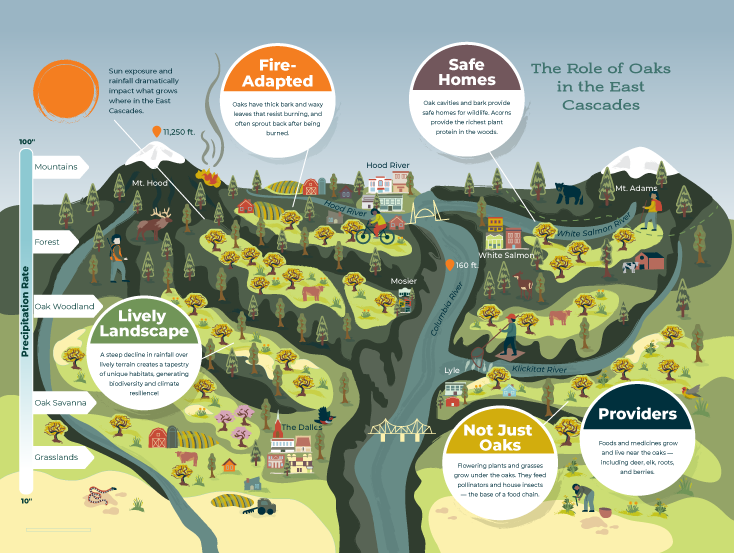Our Region
The Role of Oaks in the East Cascades.
We care about oaks because Oaks give life
Resilience to fire
Oaks have thick bark and waxy leaves that resist burning, and often sprout back after being burned.
Safe homes for wildlife
Oak cavities and bark provide safe homes for wildlife. Acorns provide the richest plant protein in the woods.
Vibrant biodiversity
A steep decline in rainfall over lively terrain creates a tapestry of unique habitats, generating biodiversity and climate resilience!
Habitat for pollinators and birds
Flowering plants and grasses grow under the oaks. They feed pollinators and house insects — the base of a food chain.
Important foods and medicines
Foods and medicines grow and live near the oaks — including deer, elk, roots, and berries.
Sun exposure and rainfall dramatically impact what grows where in the East Cascades.

The Role of Oaks
The Columbia River Gorge is the only place on Earth where a major continental river flows through a volcanic mountain range. The gorge brings moist, warm air through the Cascade Mountains, gentling the climate of the interior plateau and allowing Oregon white oak to establish and thrive. A precipitous drop in rainfall and elevation also occurs here, and these combined effects create a tapestry of unique microclimates that support a wide array of plants and animals, some of them only found here.
These microclimates coax East Cascades oaks into different growth habits. A lone oak may be a monumental figure whose arching branches are silhouetted upon a grass savanna. On windswept slopes, oaks dwarfed by harsher conditions may huddle by the thousands in a shrub-like tangle. No matter their form, oaks persevere, providing valuable habitat and iconic scenery across this diverse landscape.
The tapestry of microclimates generates exceptional biodiversity, and it increases the likelihood that plants and animals will be able to adapt to climate change by moving across those gradients to find more suitable habitats. Protecting climate corridors and learning how to care for these complex habitats are top priorities in ECOP’s strategic plan.

